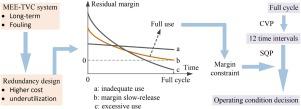Chemical Engineering Research and Design ( IF 3.7 ) Pub Date : 2022-01-06 , DOI: 10.1016/j.cherd.2021.12.050 Chun-Bo Chen 1 , Xiong-Lin Luo 1 , Lin Sun 1

|
The slow time-varying fouling accumulation is the biggest obstacle to the full-cycle operation of the multi-effect evaporation with thermal vapor compression (MEE-TVC) desalination system. In order to avoid the impact of increased fouling resistance in fresh water production, the heat transfer area is generally oversized during design, but the utilization of redundant heat transfer area is unreasonable. The analysis has found that the reduction of feed seawater flow rate in the MEE-TVC system will increase the required heat transfer area for normal production, but will also reduce the external motive steam consumption. Based on this, a margin slow released full-cycle optimization method is proposed. This method continuously adjusts the operating conditions to adapt to the state changes of the MEE-TVC system, which not only makes full use of the redundant heat transfer area, but also reduces the full-cycle energy consumption. Furthermore, it also avoids the rapid exhaustion of the motive steam margin, so that the operating performance of the system is always better than that under the design condition during the full cycle.
中文翻译:

多效蒸发淡化系统时变慢结垢特性的余量缓释全周期优化
缓慢的时变污垢积累是多效蒸发热蒸汽压缩(MEE-TVC)海水淡化系统全循环运行的最大障碍。为避免淡水生产中结垢阻力增加的影响,设计时传热面积普遍偏大,但多余传热面积的利用不合理。分析发现,MEE-TVC系统中进水海水流量的降低会增加正常生产所需的传热面积,但也会减少外部动力蒸汽消耗。在此基础上,提出了一种边际缓释全周期优化方法。该方法不断调整运行条件以适应 MEE-TVC 系统的状态变化,既充分利用了多余的传热面积,又降低了全循环能耗。此外,它还避免了动力蒸汽余量的快速耗尽,使系统在全循环期间的运行性能始终优于设计条件下的运行性能。











































 京公网安备 11010802027423号
京公网安备 11010802027423号